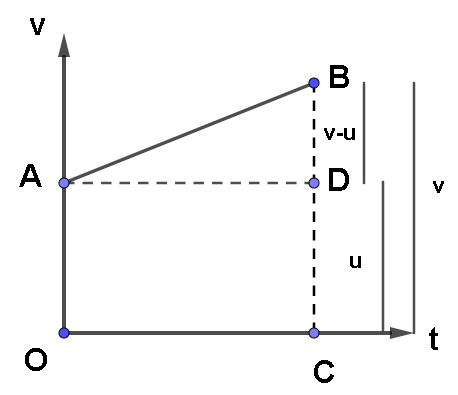Question
Question: Derive the third equation of the motion-...
Derive the third equation of the motion-
Explanation
Solution
The third equation of motion is the relationship between final velocity ‘v’, initial velocity ‘u’ , acceleration ‘and distance travelled ‘s’. We will start by considering that a body is moving with uniform acceleration. We will plot the v-t (velocity-time) graph for the body and using the graph we will reach the equation.
Complete step-by-step solution:
Let us first know a few terms:
- initial velocity is the velocity with which the body first starts moving.
- final velocity- velocity the body attains after completing its motion.
Let us start by considering a body, moving on a plane with uniform acceleration ’a’. let ‘u’ be its initial velocity ’v’ be its final velocity, ‘t’ be time travelled and ‘s’ be distance travelled. And ‘a’ is the acceleration .
We will plot a( v-t) graph to derive this equation:
Look at the following graph,

Here: OA=CD=u
BC=v
AND, OC=AD=t
As total height is v, then the height BD=BC-BD.
That is BD=v-u
We know that the slope of the v-t graph gives acceleration.
Hence, a=ADBD
a=OCBC−CD
a=tv−u
t=av−u−−−−−−−−−−−(1)
Distance travelled by the body in time t= area enclosed by v-t graph.
We see that there is a trapezium formed with height ‘t’ and sum of parallel sides as ‘u’ and ‘v’ .
Hence the distance travelled by the body =area of the trapezium in the graph.
X=area of trapezium
x=21×OC×(OA+BC)
x=21×t×(u+v)
Now substituting value of t from equation 1, we get
x=21×(av−u)×(u+v)
x=2a1×(v−u)×(u+v)
x=2a1×(v2−u2)
Or, x2a=(v2−u2)
Substituting x=s we get :
2as=(v2−u2)
∴v2=u2+2as
Hence derived.
Note: The slope under the (v-t) graph gives acceleration.
The area under the curve of a (v-t) graph gives the displacement.
Remember to write BD=v-u , otherwise the whole derivation could go wrong.
Also all the equations of motion can be applied only when the acceleration is constant.
